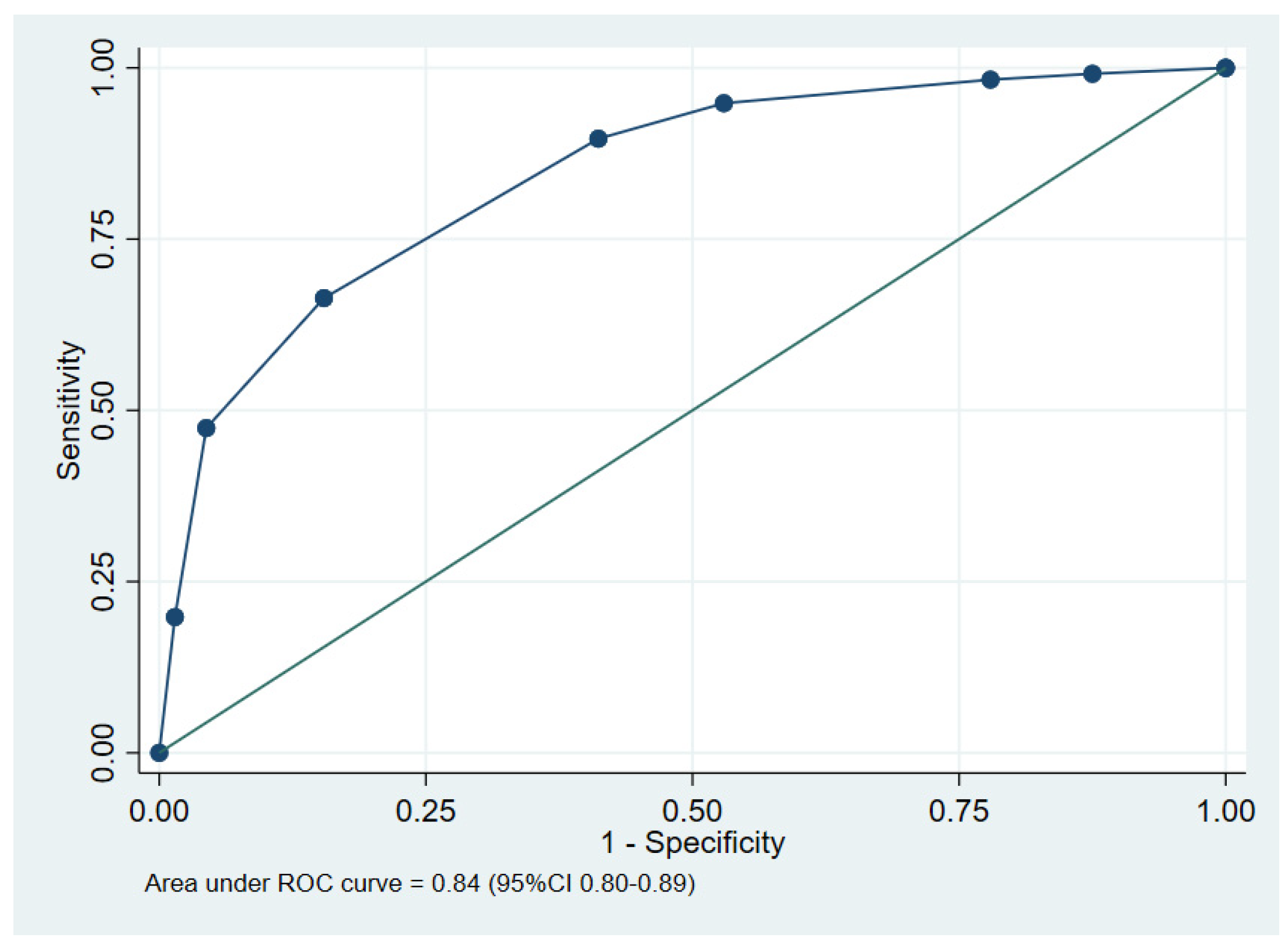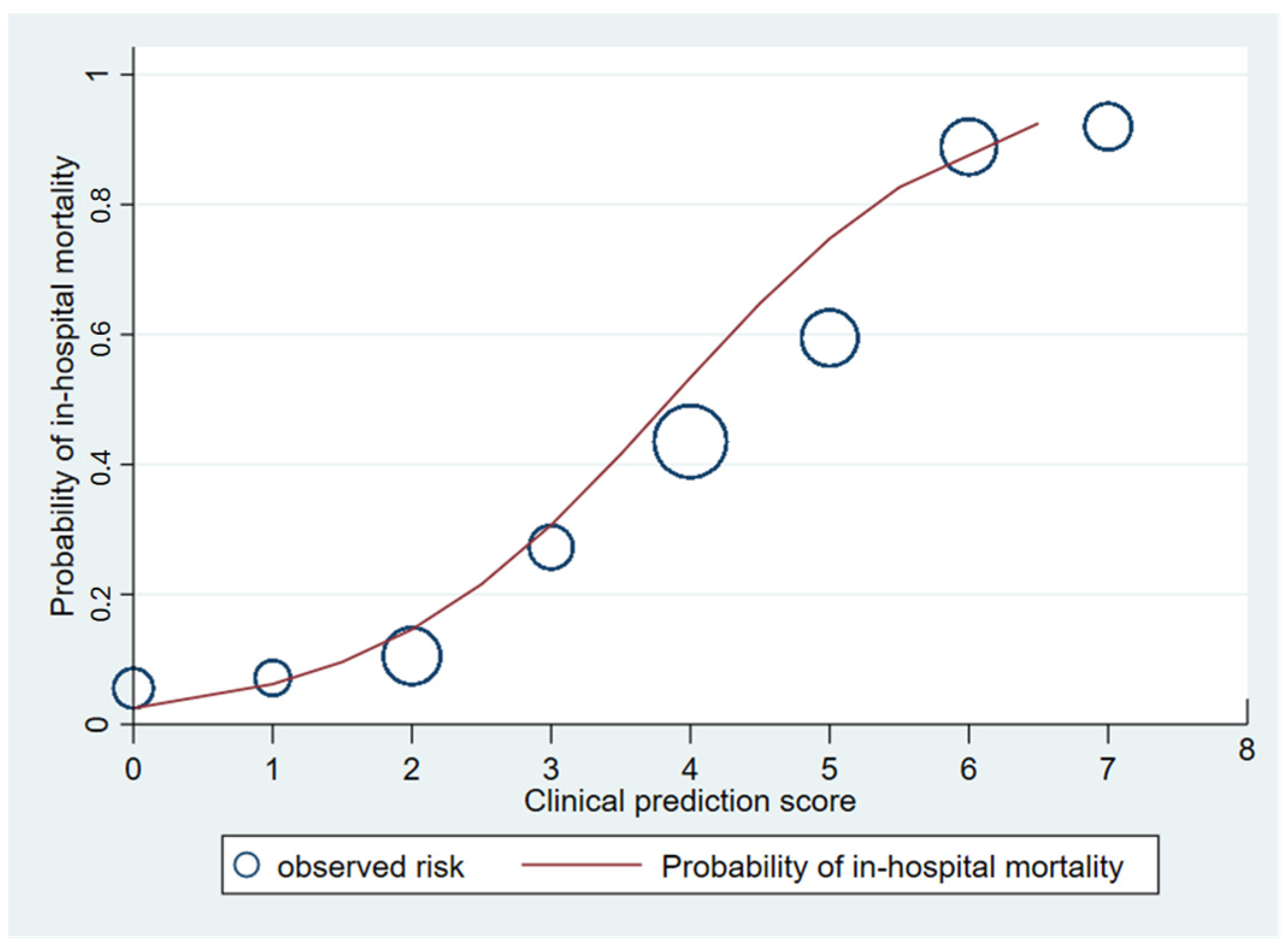Clinical Prediction Rules for In-Hospital Mortality Outcome in Melioidosis Patients
Abstract
:1. Introduction
2. Materials and Methods
2.1. Participants
2.2. Outcomes
2.3. Predictors
2.4. Statistical Analysis
3. Results
4. Discussion
5. Conclusions
Supplementary Materials
Author Contributions
Funding
Institutional Review Board Statement
Informed Consent Statement
Data Availability Statement
Acknowledgments
Conflicts of Interest
References
- Whitmore, A.S.; Krishnaswami, C.S. An account of the discovery of a hitherto un described infective disease occurring among the population of rangoon. Indian Med. Gaz. 1912, 47, 262–267. [Google Scholar]
- Molyneux, D.H.; Savioli, L.; Engels, D. Neglected Tropical Diseases: Progress towards Addressing the Chronic Pandemic. Lancet 2017, 389, 312–325. [Google Scholar] [CrossRef] [PubMed]
- Gassiep, I.; Armstrong, M.; Norton, R. Human Melioidosis. Clin. Microbiol. Rev. 2020, 33, 1110–1128. [Google Scholar] [CrossRef] [PubMed]
- Limmathurotsakul, D.; Wongratanacheewin, S.; Teerawattanasook, N.; Wongsuvan, G.; Chaisuksant, S.; Chetchotisakd, P.; Chaowagul, W.; Day, N.P.J.; Peacock, S.J. Increasing Incidence of Human Melioidosis in Northeast Thailand. Am. J. Trop. Med. Hyg. 2010, 82, 1113–1117. [Google Scholar] [CrossRef] [PubMed]
- Hinjoy, S.; Hantrakun, V.; Kongyu, S.; Kaewrakmuk, J.; Wangrangsimakul, T.; Jitsuronk, S.; Saengchun, W.; Bhengsri, S.; Akarachotpong, T.; Thamthitiwat, S.; et al. Melioidosis in Thailand: Present and Future. Trop. Med. Infect. Dis. 2018, 3, 38. [Google Scholar] [CrossRef] [PubMed]
- Gassiep, I.; Ganeshalingam, V.; Chatfield, M.D.; Harris, P.N.A.; Norton, R.E. Melioidosis: Laboratory Investigations and Association with Patient Outcomes. Am. J. Trop. Med. Hyg. 2022, 106, 54–59. [Google Scholar] [CrossRef] [PubMed]
- Domthong, P.; Chaisuksant, S.; Sawanyawisuth, K. What Clinical Factors Are Associated with Mortality in Septicemic Melioidosis? A Report from an Endemic Area. J. Infect. Dev. Ctries. 2016, 10, 404–409. [Google Scholar] [CrossRef]
- Mardhiah, K.; Wan-Arfah, N.; Naing, N.N.; Hassan, M.R.A.; Chan, H.K. The Cox Model of Predicting Mortality among Melioidosis Patients in Northern Malaysia: A Retrospective Study. Medicine 2021, 100, E26160. [Google Scholar] [CrossRef] [PubMed]
- Chantratita, N.; Phunpang, R.; Yarasai, A.; Dulsuk, A.; Yimthin, T.; Onofrey, L.A.; Coston, T.D.; Thiansukhon, E.; Chaisuksant, S.; Tanwisaid, K.; et al. Characteristics and One Year Outcomes of Melioidosis Patients in Northeastern Thailand: A Prospective, Multicenter Cohort Study. Lancet Reg. Health-Southeast Asia 2023, 9, 100118. [Google Scholar] [CrossRef]
- Chayangsu, S.; Suankratay, C.; Tantraworasin, A.; Khorana, J. The Predictive Factors Associated with In-Hospital Mortality of Melioidosis: A Cohort Study. Medicina 2024, 60, 654. [Google Scholar] [CrossRef]
- Sullivan, R.P.; Marshall, C.S.; Anstey, N.M.; Ward, L.; Currie, B.J. 2020 Review and Revision of the 2015 Darwin Melioidosis Treatment Guideline; Paradigm Drift Not Shift. PLoS Negl. Trop. Dis. 2020, 14, e0008659. [Google Scholar] [CrossRef] [PubMed]
- Chierakul, W.; Anunnatsiri, S.; Short, J.M.; Maharjan, B.; Mootsikapun, P.; H Simpson, A.J.; Limmathurotsakul, D.; Cheng, A.C.; Stepniewska, K.; Newton, P.N.; et al. Two Randomized Controlled Trials of Ceftazidime Alone versus Ceftazidime in Combination with Trimethoprim-Sulfamethoxazole for the Treatment of Severe Melioidosis. Clin. Infect. Dis. 2005, 41, 1105–1113. [Google Scholar] [CrossRef] [PubMed]
- Simpson, A.J.H.; Suputtamongkol, Y.; Smith, M.D.; Angus, B.J.; Rajanuwong, A.; Wuthiekanun, V.; Howe, P.A.; Walsh, A.L.; Chaowagul, W.; White, N.J. Comparison of Imipenem and Ceftazidime as Therapy for Severe Melioidosis. Clin. Infect. Dis. 1999, 29, 381–387. [Google Scholar] [CrossRef] [PubMed]
- Chetchotisakd, P.; Porramatikul, S.; Mootsikapun, P.; Anunnatsiri, S.; Thinkhamrop, B. Randomized, Double-Blind, Controlled Study of Cefoperazone-Sulbactam Plus Cotrimoxazole versus Ceftazidime Plus Cotrimoxazole for the Treatment of Severe Melioidosis. Clin. Infect. Dis. 2001, 33, 29–34. [Google Scholar] [CrossRef] [PubMed]
- Cheng, A.C.; Jacups, S.P.; Anstey, N.M.; Cuttle, B.J. A Proposed Scoring System for Predicting Mortality in Melioidosis. Trans. R. Soc. Trop. Med. Hyg. 2003, 97, 577–581. [Google Scholar] [CrossRef] [PubMed]
- Meumann, E.M.; Cheng, A.C.; Ward, L.; Currie, B.J. Clinical Features and Epidemiology of Melioidosis Pneumonia: Results from a 21-Year Study and Review of the Literature. Clin. Infect. Dis. 2012, 54, 362–369. [Google Scholar] [CrossRef] [PubMed]
- Pitman, M.C.; Luck, T.; Marshall, C.S.; Anstey, N.M.; Ward, L.; Currie, B.J. Intravenous Therapy Duration and Outcomes in Melioidosis: A New Treatment Paradigm. PLoS Negl. Trop. Dis. 2015, 9, e0008659. [Google Scholar] [CrossRef] [PubMed]
- Raj, S.; Sistla, S.; Sadanandan, D.M.; Kadhiravan, T.; Rameesh, B.M.S.; Amalnath, D. Clinical Profile and Predictors of Mortality among Patients with Melioidosis. J. Glob. Infect. Dis. 2023, 15, 72–78. [Google Scholar] [CrossRef] [PubMed]
- Lauw, F.N.; Simpson, A.J.H.; Prins, J.M.; Smith, M.D.; Kurimoto, M.; Van Deventer, S.J.H.; Speelman, P.; Chaowagul, W.; White, N.J.; Van Der Poll, T. Elevated Plasma Concentrations of Interferon (IFN)-g and the IFN-g-Inducing Cytokines Interleukin (IL)-18, IL-12, and IL-15 in Severe Melioidosis. J. Infect. Dis. 1999, 180, 1878–1885. [Google Scholar] [CrossRef]
- Simpson, A.J.H.; Smith, M.D.; Weverling, G.J.; Suputtamongkol, Y.; Angus, B.J.; Chaowagul, W.; White, N.J.; Van Deventer, S.J.H.; Prins, J.M.; Simpson, A. Prognostic Value of Cytokine Concentrations (Tumor Necrosis Factor-a, Interleukin-6, and Interleukin-10) and Clinical Parameters in Severe Melioidosis. J. Infect. Dis. 1999, 181, 621–625. [Google Scholar] [CrossRef]
- Wright, S.W.; Kaewarpai, T.; Lovelace-Macon, L.; Ducken, D.; Hantrakun, V.; Rudd, K.E.; Teparrukkul, P.; Phunpang, R.; Ekchariyawat, P.; Dulsuk, A.; et al. A 2-Biomarker Model Augments Clinical Prediction of Mortality in Melioidosis. Clin. Infect. Dis. 2021, 72, 821–828. [Google Scholar] [CrossRef] [PubMed]



| Characteristics | Missing n (%) | Non-Survival (n = 125) | Survival (n = 157) | p-Value |
|---|---|---|---|---|
| Male 1, n (%) | 0 | 89 (71.2) | 118 (75.2) | 0.499 |
| Age (years) 2, mean ± SD | 0 | 59.0 ± 15.5 | 55.0 ± 13.2 | 0.022 |
| Age ≥ 60 years 1, n (%) | 68 (54.4) | 62 (39.5) | 0.016 | |
| Comorbid at least 1 disease 1, n (%) | 0 | 100 (80.0) | 127 (80.9) | 1.881 |
| Comorbid 1, n (%) (DM/CKD/Cirrhosis/Thalassemia) | 0 | 75 (60.0) | 100 (63.7) | 0.539 |
| qSOFA score 3, median (IQR) | 0 | 1 (1–2) | 1 (0–1) | <0.001 |
| qSOFA score ≥ 2 1, n (%) | 49 (39.2) | 17 (10.8) | <0.001 | |
| SIRS score 2, mean ± SD | 2 (0.7) | 2.9 ± 0.9 | 2.5 ± 1.1 | 0.002 |
| SIRS score ≥ 2 1, n (%) | 115 (92.0) | 125 (80.7) | 0.009 | |
| Body mass index 2, mean ± SD | 19 (6.7) | 20.5 ± 3.7 | 21.5 ± 3.8 | 0.025 |
| Clinical syndromes 1, n (%) | 0 | <0.001 | ||
| Localized or bacteremia * | 35 (28.0) | 80 (51.0) | ||
| Disseminated form ** | 90 (72.0) | 77 (49.0) | ||
| Abnormal chest X-ray finding 1, n (%) | 2 (0.7) | 106 (85.5) | 71 (45.5) | <0.001 |
| %Neutrophils 2, mean ± SD | 3 (1.1) | 85.5 ± 11.2 | 81.6 ± 10.7 | 0.003 |
| %Neutrophils ≥ 851, n (%) | 81 (64.8) | 61 (39.6) | <0.001 | |
| Platelet, cells/mm3 3, median (IQR) | 2 (0.7) | 163,000 (84,000–219,000) | 213,000 (151,000–323,000) | <0.001 |
| Platelet < 100,000 cells/mm3 1, n (%) | 37 (29.6) | 16 (10.3) | <0.001 | |
| BUN, mg/dL3, median (IQR) | 3 (1.1) | 37 (22–59) | 17 (12–28) | <0.001 |
| BUN ≥ 20 mg/dL 1, n (%) | 97 (77.6) | 61 (39.6) | <0.001 | |
| Creatinine, mg/dL 3, median (IQR) | 4 (1.4) | 2.1 (1.2–3.4) | 1.1 (0.8–1.6) | <0.001 |
| Creatinine ≥ 1.5 mg/dL1, n (%) | 79 (63.7) | 44 (28.6) | <0.001 | |
| AST, U/L 3, median (IQR) | 24 (8.5) | 109 (61–261) | 55 (36–98.5) | <0.001 |
| AST ≥ 50 U/L 1, n (%) | 101 (85.6) | 78 (55.7) | <0.001 | |
| Albumin, g/dL 2, mean ± SD | 23 (8.2) | 2.5 ± 0.6 | 2.8 ± 0.6 | <0.001 |
| Albumin ≤ 3 g/dL 1, n (%) | 97 (81.5) | 85 (60.7) | <0.001 | |
| HCO3, mEq/L 2, mean ± SD | 5 (1.8) | 17.3 ± 6.5 | 22.1 ± 5.6 | <0.001 |
| HCO3 ≤ 20 mEq/L 1, n (%) | 86 (69.4) | 42 (27.5) | <0.001 |
| Parameters | Univariable OR | 95% CI of uOR | p-Value | Multivariable OR | 95% CI of mOR | p-Value |
|---|---|---|---|---|---|---|
| qSOFA score ≥ 2 | 5.31 | 2.86–9.85 | <0.001 | 2.39 | 1.12–5.11 | 0.025 |
| Abnormal Chest X-ray | 7.05 | 3.91–12.73 | <0.001 | 5.86 | 2.79–12.29 | <0.001 |
| Creatinine ≥ 1.5 mg/dL | 4.39 | 2.65–7.28 | <0.001 | 2.80 | 1.38–5.69 | 0.004 |
| AST ≥ 50 U/L | 4.72 | 2.56–8.71 | <0.001 | 4.03 | 1.93–8.42 | <0.001 |
| HCO3 ≤ 20 mEq/L | 5.98 | 3.55–10.07 | <0.001 | 2.96 | 1.48–5.92 | 0.002 |
| Diagnostic Parameter | Coefficients | Transformed Coefficient | Assigned Score |
|---|---|---|---|
| qSOFA ≥ 2 | |||
| No | - | - | 0 |
| Yes | 0.87 | 1 | 1 |
| Abnormal Chest X-ray | |||
| No | - | - | 0 |
| Yes | 1.77 | 2.03 | 2 |
| Creatinine ≥ 1.5 mg/dL | |||
| No | - | - | 0 |
| Yes | 1.03 | 1.18 | 1 |
| AST ≥ 50 U/L | |||
| No | - | - | 0 |
| Yes | 1.39 | 1.60 | 2 |
| HCO3 ≤ 20 mEq/L | |||
| No | - | - | 0 |
| Yes | 1.08 | 1.25 | 1 |
| Risk Level | Fetal Melioidosis (%) | Non-Fatal Melioidosis (%) | PPV (%) | LR+ | 95% CI of LR+ | p-Value |
|---|---|---|---|---|---|---|
| Low (score 0–3) | 12 (13.0) | 80 (87.0) | 13.0 | 0.18 | 0.10–0.31 | <0.001 |
| High (score 4–7) | 104 (65.0) | 56 (35.0) | 65.0 | 2.18 | 1.76–2.69 | <0.001 |
Disclaimer/Publisher’s Note: The statements, opinions and data contained in all publications are solely those of the individual author(s) and contributor(s) and not of MDPI and/or the editor(s). MDPI and/or the editor(s) disclaim responsibility for any injury to people or property resulting from any ideas, methods, instructions or products referred to in the content. |
© 2024 by the authors. Licensee MDPI, Basel, Switzerland. This article is an open access article distributed under the terms and conditions of the Creative Commons Attribution (CC BY) license (https://creativecommons.org/licenses/by/4.0/).
Share and Cite
Chayangsu, S.; Suankratay, C.; Tantraworasin, A.; Khorana, J. Clinical Prediction Rules for In-Hospital Mortality Outcome in Melioidosis Patients. Trop. Med. Infect. Dis. 2024, 9, 146. https://doi.org/10.3390/tropicalmed9070146
Chayangsu S, Suankratay C, Tantraworasin A, Khorana J. Clinical Prediction Rules for In-Hospital Mortality Outcome in Melioidosis Patients. Tropical Medicine and Infectious Disease. 2024; 9(7):146. https://doi.org/10.3390/tropicalmed9070146
Chicago/Turabian StyleChayangsu, Sunee, Chusana Suankratay, Apichat Tantraworasin, and Jiraporn Khorana. 2024. "Clinical Prediction Rules for In-Hospital Mortality Outcome in Melioidosis Patients" Tropical Medicine and Infectious Disease 9, no. 7: 146. https://doi.org/10.3390/tropicalmed9070146
APA StyleChayangsu, S., Suankratay, C., Tantraworasin, A., & Khorana, J. (2024). Clinical Prediction Rules for In-Hospital Mortality Outcome in Melioidosis Patients. Tropical Medicine and Infectious Disease, 9(7), 146. https://doi.org/10.3390/tropicalmed9070146







